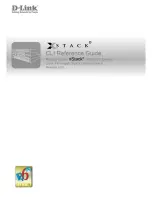
Glossary
506
NS3552-8P-2S-V2 User Manual
TELNET
TELetype NETwork. It is a terminal emulation protocol that
uses the Transmission Control Protocol (TCP) and provides a
virtual connection between TELNET server and TELNET client.
TELNET enables the client to control the server and
communicate with other servers on the network. To start a
Telnet session, the client user must log in to a server by
entering a valid username and password. Then, the client user
can enter commands through the Telnet program just as if they
were entering commands directly on the server console.
TFTP
Trivial File Transfer Protocol. It is transfer protocol that uses
the User Datagram Protocol (UDP) and provides file writing
and reading, but it does not provides directory service and
security features.
ToS
Type of Service. It is implemented as the IPv4 ToS priority
control. It is fully decoded to determine the priority from the 6-
bit ToS field in the IP header. The most significant six bits of
the ToS field are fully decoded into 64 possibilities, and the
singular code that results is compared against the
corresponding bit in the IPv4 ToS priority control bit (0~63).
TLV
Type Length Value. A LLDP frame can contain multiple pieces
of information. Each of these pieces of information is known as
a TLV.
TKIP
Temporal Key Integrity Protocol. It is used in WPA to replace
WEP with a new encryption algorithm. TKIP comprises the
same encryption engine and RC4 algorithm defined for WEP.
The key used for encryption in TKIP is 128 bits and changes
the key used for each packet.
U
UDP
User Datagram Protocol. It is a communications protocol that
uses the Internet Protocol (IP) to exchange the messages
between computers.
UDP is an alternative to the Transmission Control Protocol
(TCP) that uses the Internet Protocol (IP). Unlike TCP, UDP
does not provide the service of dividing a message into packet
datagrams, and UDP doesn't provide reassembling and
sequencing of the packets. This means that the application
program that uses UDP must be able to make sure that the
entire message has arrived and is in the right order. Network
applications that want to save processing time because they
have very small data units to exchange may prefer UDP to
TCP.
UDP provides two services not provided by the IP layer. It
provides port numbers to help distinguish different user
requests and, optionally, a checksum capability to verify that
the data arrived intact.
Common network applications that use UDP include the
Domain Name System (DNS), streaming media applications
such as IPTV, Voice over IP (VoIP), and Trivial File Transfer
Protocol (TFTP).
Summary of Contents for NS3552-8P-2S-V2
Page 1: ...NS3552 8P 2S V2 User Manual P N 1073552 EN REV B ISS 25JAN19 ...
Page 41: ...Chapter 3 Switch management NS3552 8P 2S V2 User Manual 39 ...
Page 73: ...Chapter 4 Web configuration NS3552 8P 2S V2 User Manual 71 ...
Page 147: ...Chapter 4 Web configuration NS3552 8P 2S V2 User Manual 145 ...
Page 511: ......



































